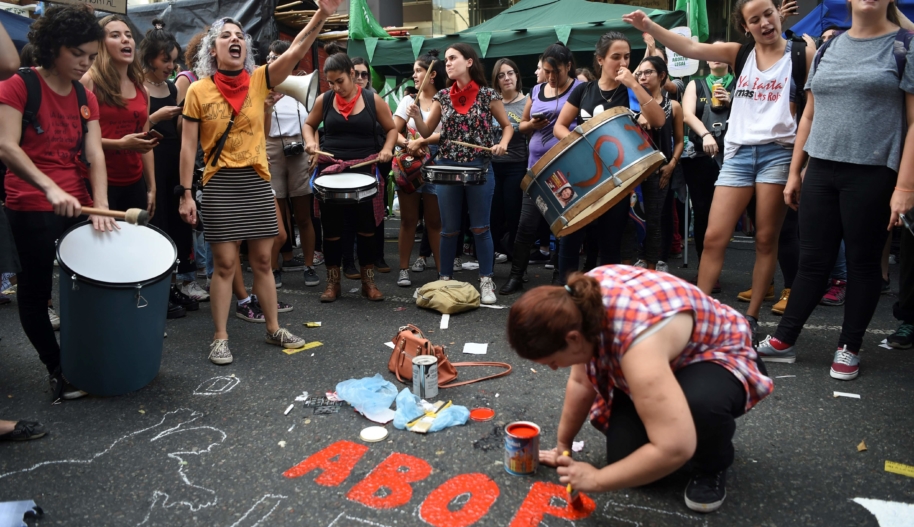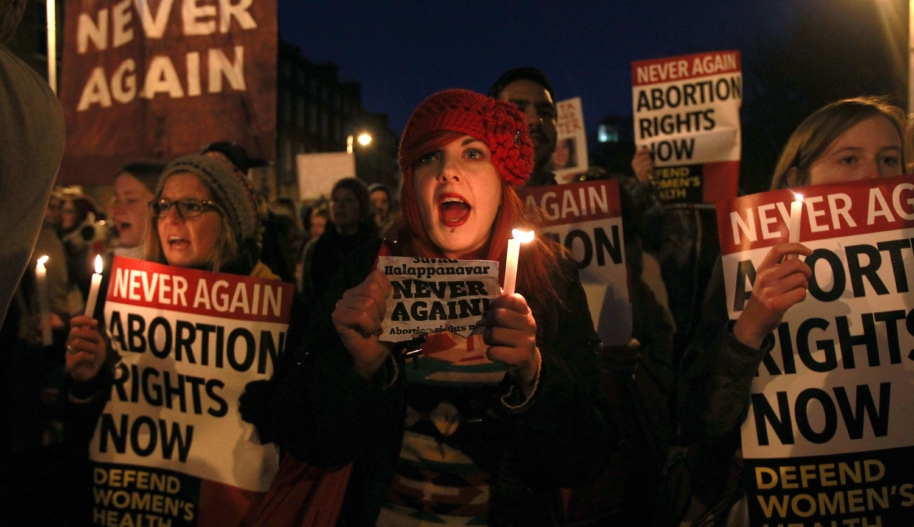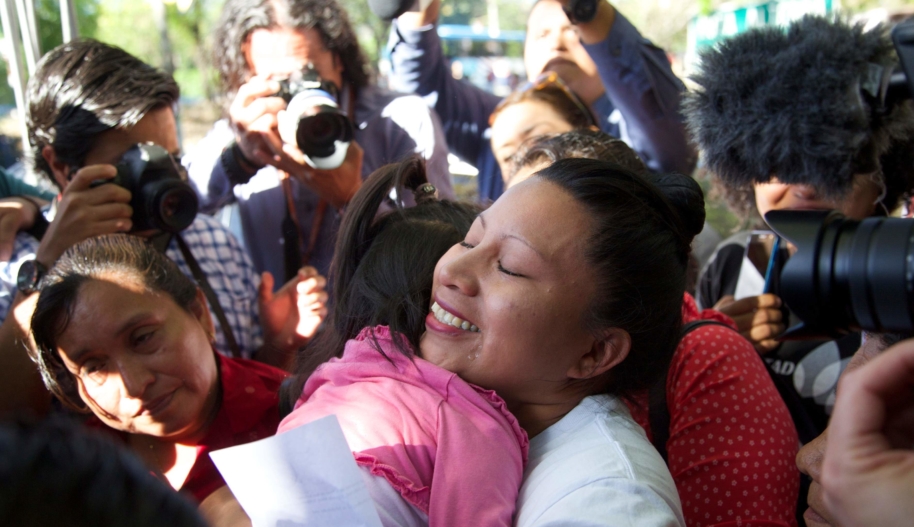Overview
An abortion is a medical procedure that ends a pregnancy. It is a basic healthcare need for millions of women, girls and others who can become pregnant. Worldwide, an estimated 1 in 4 pregnancies end in an abortion every year.
But while the need for abortion is common, access to safe and legal abortion services is far from guaranteed for those who may need abortion services.
In fact, access to abortion is one of the most hotly contested topics globally, and the debate is clouded by misinformation about the true ramifications of restricting access to this basic healthcare service.
Do you live in the United States? We’re asking our supporters in the US to call their Senators to make sure they vote YES for the Women’s Health Protection Act. Find out how you can help.
Key Facts
Here are the basic facts about abortion that everyone should know
People have abortions all the time, regardless of what the law says
Ending a pregnancy is a common decision that millions of people make – every year a quarter of pregnancies end in abortion.
And regardless of whether abortion is legal or not, people still require and regularly access abortion services. According to the Guttmacher Institute, a US-based reproductive health non-profit, the abortion rate is 37 per 1,000 people in countries that prohibit abortion altogether or allow it only in instances to save a woman’s life, and 34 per 1,000 people in countries that broadly allow for abortion, a difference that is not statistically significant.
When undertaken by a trained health-care provider in sanitary conditions, abortions are one of the safest medical procedures available, safer even than child birth.
But when governments restrict access to abortions, people are compelled to resort to clandestine, unsafe abortions, particularly those who cannot afford to travel or seek private care. Which brings us to the next point.
Criminalising abortion does not stop abortions, it just makes abortion less safe
Preventing women and girls from accessing an abortion does not mean they stop needing one. That’s why attempts to ban or restrict abortions do nothing to reduce the number of abortions, it only forces people to seek out unsafe abortions.
Unsafe abortions are defined by the World Health Organisation (WHO) as “a procedure for terminating an unintended pregnancy carried out either by persons lacking the necessary skills or in an environment that does not conform to minimal medical standards, or both.”
They estimate that 25 million unsafe abortions take place each year, the vast majority of them in developing countries.
In contrast to a legal abortion that is carried out by a trained medical provider, unsafe abortions can have fatal consequences. So much so that unsafe abortions are the third leading cause of maternal deaths worldwide and lead to an additional five million largely preventable disabilities, according to the WHO.

Almost every death and injury from unsafe abortion is preventable
Deaths and injuries from unsafe abortions are preventable. Yet such deaths are common in countries where access to safe abortion is limited or prohibited entirely, as the majority of women and girls who need an abortion because of an unwanted pregnancy are not able to legally access one.
In countries with such restrictions, the law typically allows for what are known as narrow exceptions to the legislation criminalizing abortion. These exceptions might be when pregnancy results from rape or incest, in cases of severe and fatal fetal impairment, or when there is risk to the life or health of the pregnant person. Only a small percentage of abortions are due to these reasons, meaning the majority of women and girls living under these laws might be forced to seek unsafe abortions and put their health and lives at risk.
Those who are already marginalized are disproportionately affected by such laws as they have no means to seek safe and legal services in another country or access private care. They include women and girls on low income, refugees and migrants, adolescents, lesbian, bisexual cisgender women and girls, transgender or gender non-conforming individuals, minority or Indigenous women.
The WHO has noted that one of the first steps toward avoiding maternal deaths and injuries is for states to ensure that people have access to sex education, are able to use effective contraception, have safe and legal abortion, and are given timely care for complications.
Evidence shows that abortion rates are higher in countries where there is limited access to contraception. Abortion rates are lower where people, including adolescents have information about and can access modern contraceptive methods and where comprehensive sexuality education is available and there is access to safe and legal abortion on broad grounds.
Many countries are starting to change their laws to allow for greater access to abortion
Over the last 25 years, more than 50 countries have changed their laws to allow for greater access to abortion, at times recognizing the vital role that access to safe abortion plays in protecting women’s lives and health. Ireland joined that list on 25 May 2018 when, in a long-awaited referendum, its people voted overwhelmingly to repeal the near-total constitutional ban on abortion.
Despite the trend towards reforming laws to prevent deaths and injuries, some countries, including Nicaragua and El Salvador, maintain draconian and discriminatory laws that still ban abortion in virtually all circumstances. In fact, according to the WHO, across the globe 40% of women of childbearing age live in countries with highly restrictive abortion laws, or where abortion is legal, is neither available or accessible. In these states, abortion is banned or only permitted in highly restricted circumstances, or if legal, is not accessible due to multiple barriers to access in practice.
Even in states with broader access to legal abortion, pregnant individuals can still face multiple restrictions on and barriers to access to services such as cost, biased counselling, mandatory waiting periods. The WHO has issued technical guidance for states on the need to identify and remove such barriers.

Criminalising or restricting abortion prevents doctors from providing basic care
Criminalisation and restrictive laws on abortion prevent health-care providers from doing their job properly and from providing the best care options for their patients, in line with good medical practice and their professional ethical responsibilities.
Criminalisation of abortion results in a “chilling effect”, whereby medical professionals may not understand the bounds of the law or may apply the restrictions in a narrower way than required by the law. This may be because of a number of reasons, including personal beliefs, stigma about abortion, negative stereotypes about women and girls, or the fear of criminal liability.
It also deters women and girls from seeking post-abortion care for complications due to unsafe abortion or other pregnancy related complications.
Claire Malone, a young woman from Ireland, who already had two children, shared her harrowing testimony with Amnesty International Ireland of how her right to health was undermined by not being able to access an abortion due to the country’s strict abortion laws.
Claire has a number of complex and life-threatening health conditions, including pulmonary atresia and pulmonary hypertension and had her lung removed in 2014. If women with pulmonary hypertension become pregnant, they are at high risk of becoming even more gravely ill or dying in pregnancy. Claire knows this, which is what led her to seek a termination, a request that was denied by her doctors because the law prevented them from doing so.
“My doctors said they couldn’t offer a termination as my life wasn’t at risk right now, and that was it. I know they are bound by the law. But I felt like if I waited until my health got so bad that I could die, then it would be too late by then anyway. And why is a risk to my health, as bad as it already was, not enough? How much do I have to go through before my doctors are allowed to treat me?”
It’s not just cisgender women and girls who need abortions
It is not only cisgender women and girls (women and girls who were assigned female at birth) who may need access to abortion services, but also intersex people, transgender men and boys, and people with other gender identities who have the reproductive capacity to become pregnant.
One of the foremost barriers to abortion access for these individuals and groups is lack of access to healthcare. Additionally, for those who do have access to healthcare, they may face stigma and biased views in the provision of healthcare, as well as presumptions that they do not need access to contraception and abortion-related information and services. In some contexts, 28% transgender and gender non-conforming individuals report facing harassment in medical settings, and 19% report being refused medical care altogether due to their transgender status, with even higher numbers among communities of colour. This is due to many intertwining factors of poverty and race and related intersectional discrimination.
Sexual and reproductive rights advocates and LGBTI rights activists are campaigning for raising awareness on this and making abortion services available, accessible and inclusive for everybody who needs it without discrimination on any grounds.

Criminalising abortion is a form of discrimination, which further fuels stigma
Firstly, the denial of medical services, including reproductive health services that only certain individuals need is a form of discrimination.
The committee for the United Nations Convention on the Elimination of All Forms of Discrimination Against Women (CEDAW, or the Treaty for the Rights of Women), has consistently stated that restrictive abortion laws constitute discrimination against women. This applies to all women and people who can become pregnant, as the CEDAW Committee has confirmed that CEDAW’s protections, and states’ related obligations, apply to all women and therefore include discrimination against women who are lesbians, bisexual, and/or transgender, particularly given the specific forms of gendered discrimination they face.
Secondly, stigma around abortion and gender stereotyping is closely linked to the criminalisation of abortion and other restrictive abortion laws and policies.
The mere perception that abortion is unlawful or immoral leads to the stigmatization of women and girls by health care staff, family members, and the judiciary, among others. Consequently, women and girls seeking abortion risk discrimination and harassment. Some women have reported being abused and shamed by health care providers when seeking abortion services or post-abortion care.
Access to safe abortion is a matter of human right
Access to safe abortion services is a human right. Under international human rights law, everyone has a right to life, a right to health, and a right to be free from violence, discrimination, and torture or cruel, inhuman and degrading treatment.
Human rights law clearly spells out that decisions about your body are yours alone – this is what is known as bodily autonomy.
Forcing someone to carry on an unwanted pregnancy, or forcing them to seek out an unsafe abortion, is a violation of their human rights, including the rights to privacy and bodily autonomy.
In many circumstances, those who have no choice but to resort to unsafe abortions also risk prosecution and punishment, including imprisonment, and can face cruel, inhuman and degrading treatment and discrimination in, and exclusion from, vital post-abortion health care.
Access to abortion is therefore fundamentally linked to protecting and upholding the human rights of women, girls and others who can become pregnant, and thus for achieving social and gender justice.
Amnesty International believes that everyone should be free to exercise their bodily autonomy and make their own decisions about their reproductive lives including when and if they have children. It is essential that laws relating to abortion respect, protect and fulfil the human rights of pregnant persons and not force them to seek out unsafe abortions.

